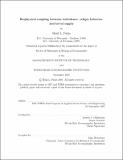| dc.contributor.advisor | Lauren S. Mullineaux. | en_US |
| dc.contributor.author | Fuchs, Heidi L | en_US |
| dc.contributor.other | Woods Hole Oceanographic Institution. | en_US |
| dc.date.accessioned | 2007-10-22T19:02:44Z | |
| dc.date.available | 2007-10-22T19:02:44Z | |
| dc.date.issued | 2005 | en_US |
| dc.identifier.uri | http://hdl.handle.net/1721.1/39193 | |
| dc.description | Thesis (Ph. D.)--Joint Program in Applied Ocean Science and Engineering (Massachusetts Institute of Technology, Dept. of Biology; and the Woods Hole Oceanographic Institution), 2005. | en_US |
| dc.description | This electronic version was submitted by the student author. The certified thesis is available in the Institute Archives and Special Collections. | en_US |
| dc.description | Includes bibliographical references. | en_US |
| dc.description.abstract | The goals of this thesis were to quantify the behavior of gastropod larvae (mud snails Ilyanassa obsoleta) in turbulence, and to investigate how that behavior affects larval supply in a turbulent coastal inlet. Gastropod larvae retract their velums and sink rapidly in strong turbulence. Turbulence-induced sinking would be an adaptive behavior if it resulted in increased larval supply and enhanced settlement in suitable coastal habitats. In laboratory experiments, mud snail larvae were found to have three behavioral modes: swimming, hovering, and sinking. The proportion of sinking larvae increased exponentially with the turbulence dissipation rate over a range comparable to turbulence in a tidal inlet, and the mean larval vertical velocity shifted from upward to downward in turbulence resembling energetic nearshore areas. The larval response to turbulence was incorporated in a vertical advection-diffusion model to characterize the effects of this behavior on larval supply and settlement in a tidal channel. Compared to passive larvae, larvae that sink in turbulence have higher near-bed concentrations throughout flood and ebb tides. | en_US |
| dc.description.abstract | (cont.) This high larval supply enables behaving larvae to settle more successfully than passive larvae in strong currents characteristic of turbulent tidal inlets. A study was conducted at Barnstable Harbor, MA to estimate the responses of larvae to turbulence in the field. Gastropod larvae from different coastal environments had genus-specific responses to turbulence, suggesting that larvae use turbulence for large-scale habitat selection. On ebb tides, mud snail larvae had a similar response to turbulence as in the laboratory, with greater sinking velocities in strong turbulence. Behavior estimates differed for flood and ebb tides, indicating that additional physical cues influence behavior. Turbulence-induced sinking behavior would enhance retention and promote settlement of mud snail larvae in habitats like Barnstable Harbor. | en_US |
| dc.description.statementofresponsibility | by Heidi L. Fuchs. | en_US |
| dc.format.extent | 104 p. | en_US |
| dc.language.iso | eng | en_US |
| dc.publisher | Massachusetts Institute of Technology | en_US |
| dc.rights | M.I.T. theses are protected by copyright. They may be viewed from this source for any purpose, but reproduction or distribution in any format is prohibited without written permission. See provided URL for inquiries about permission. | en_US |
| dc.rights.uri | http://dspace.mit.edu/handle/1721.1/7582 | |
| dc.subject | /Woods Hole Oceanographic Institution. Joint Program in Applied Ocean Science and Engineering. | en_US |
| dc.subject | Biology. | en_US |
| dc.subject | Woods Hole Oceanographic Institution. | en_US |
| dc.subject.lcsh | Benthic animals Larvae | en_US |
| dc.subject.lcsh | Larvae Dispersal | en_US |
| dc.subject.lcsh | Turbidity currents | en_US |
| dc.title | Biophysical coupling between turbulence, veliger behavior, and larval supply | en_US |
| dc.type | Thesis | en_US |
| dc.description.degree | Ph.D. | en_US |
| dc.contributor.department | Joint Program in Applied Ocean Physics and Engineering | en_US |
| dc.contributor.department | Woods Hole Oceanographic Institution | en_US |
| dc.contributor.department | Massachusetts Institute of Technology. Department of Biology | |
| dc.identifier.oclc | 65197412 | en_US |
